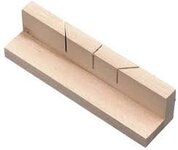axolotl_laserbeam
Member
Hey guys, I hope you're doing well,
I just wanted to show you this pen that I made a couple of days ago. Basically, the workspace that I'm in doesn't have room for a table saw or bandsaw. This is unfortunate because I am very interested in becoming better at segmenting. To compensate, I made a miter jig for my coping saw. With my first use of the miter jig, this is what I was able to make. If you have any suggestions on segmenting without a table saw or bandsaw, please tell me everything.





I just wanted to show you this pen that I made a couple of days ago. Basically, the workspace that I'm in doesn't have room for a table saw or bandsaw. This is unfortunate because I am very interested in becoming better at segmenting. To compensate, I made a miter jig for my coping saw. With my first use of the miter jig, this is what I was able to make. If you have any suggestions on segmenting without a table saw or bandsaw, please tell me everything.

